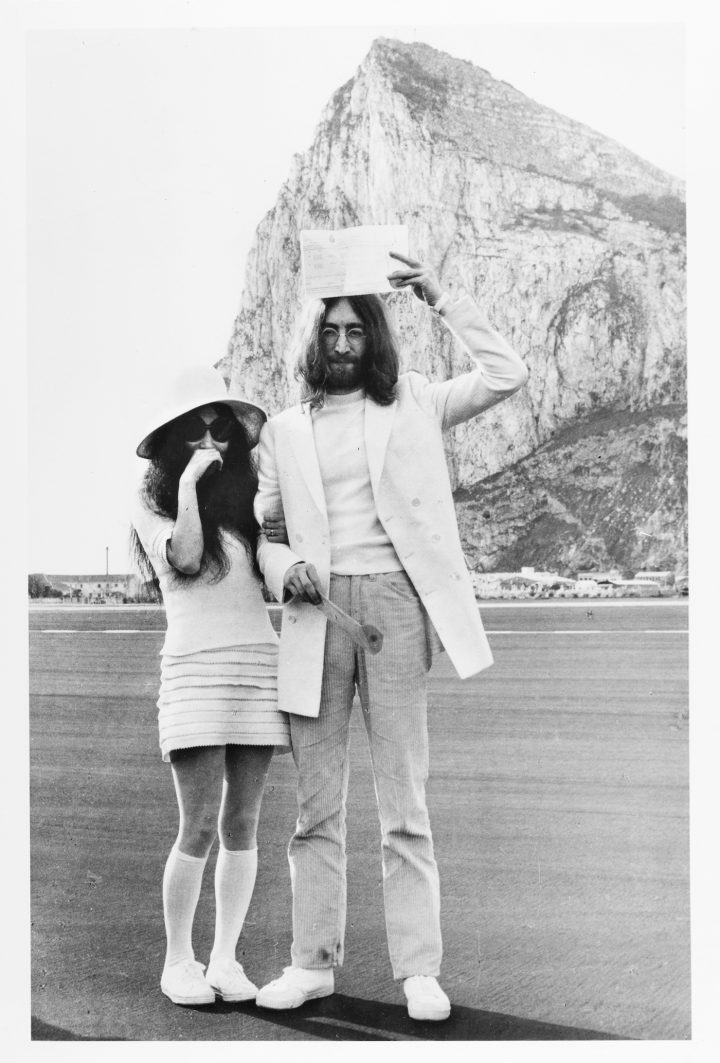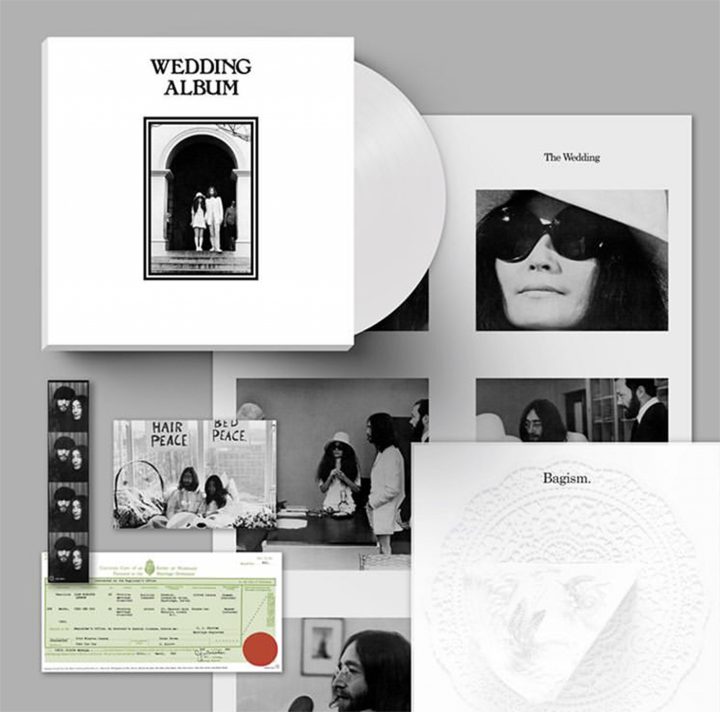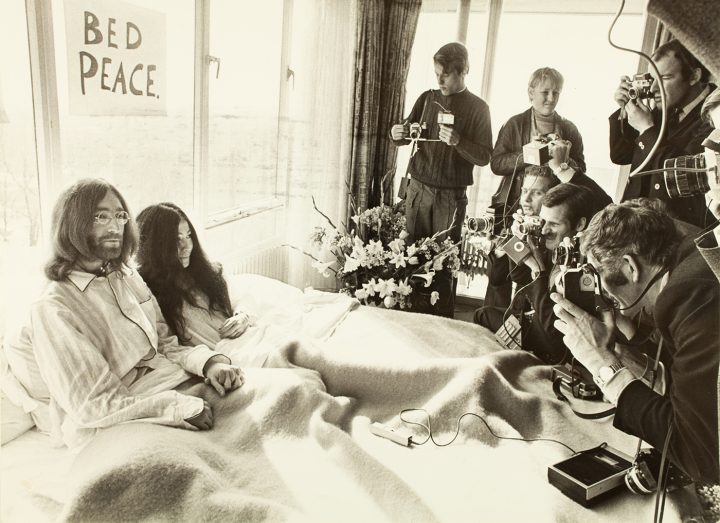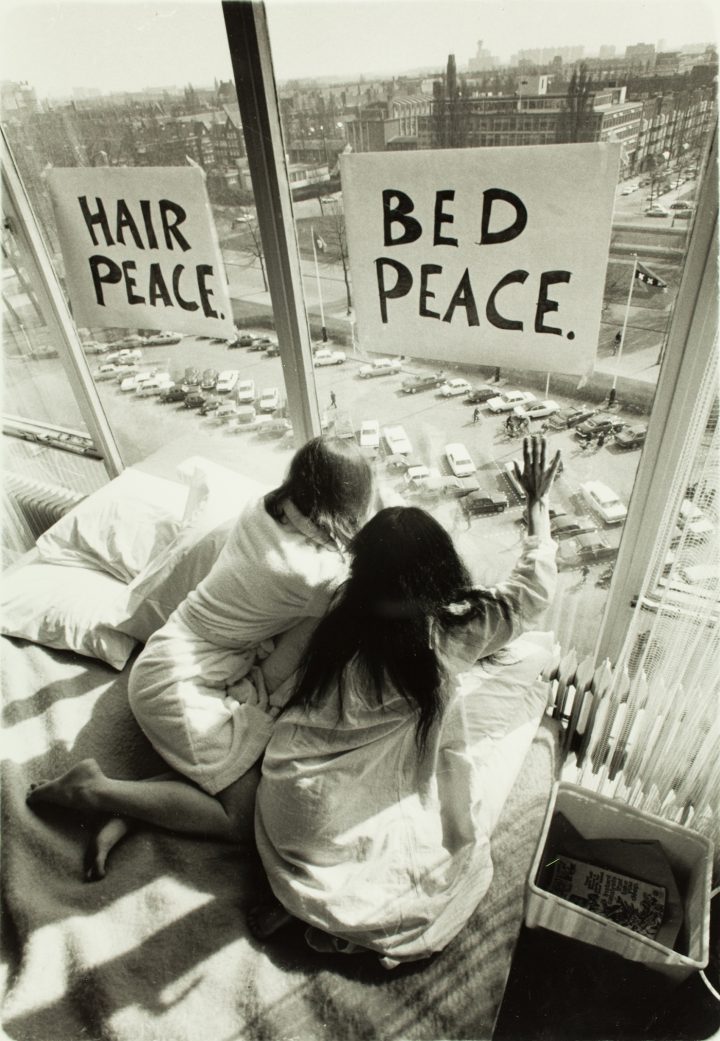hyperallergic.com
John and Yoko’s Wedding Album, Once an Oddity, Now an Icon
An unlikely element of Lennon and Ono’s late-1960s peace campaign was an aural selfie, ahead of its time.
Edward M. Gómez
March 30 2019

Yoko Ono and John Lennon (holding their marriage certificate) on their wedding day in Gibraltar, March 20, 1969 (photo by David Nutter, ©Yoko Ono)
By the time John Lennon and Yoko Ono released their Wedding Album on the Beatles’ Apple Records label in late 1969, seven months after marrying in a low-key civil ceremony in the tiny, British Overseas Territory of Gibraltar, the Liverpool-born Lennon, then one of the most famous rock stars in the world, knew that even his most off-the-cuff pronouncements would be gobbled up and analyzed by the media as emblematic reflections of theZeitgeist.
Meanwhile, Ono, who had emerged from the more rarified precincts of New York’s avant-garde art-and-music scene, was still being served a crash course in the persistent, often invasive nature of the international media’s omnipresent gaze.
Now, 50 years after Lennon and Ono, each fresh from a divorce, became husband and wife on March 20, 1969, the US-based labels Secretly Canadian and Chimera Music are jointly re-releasingWedding Album, its vinyl-LP and compact-disc formats complete with faithful reproductions of the original vinyl record’s innovative packaging.

Looking back at what can now be appreciated as a pioneering use of the record album as a vehicle (postmodernist theorists would call it a “site”) for conveying a range of messages and as a kind of art object in its own right, its unlikely status as an icon of its time may finally come more clearly into focus.
The year 1969 was a big one for the newly married Lennon and Ono, and for the world at large. In popular music, a new band, Led Zeppelin, released its first album; Elvis Presley returned to the studio to record material for a big comeback; and the Beatles gave what would turn out to be their last-ever public performance, on the roof of the London building that housed Apple, their multimedia company. (All of those events took place in January alone.)
The same year saw a student set himself on fire in Prague to protest the Soviet-led invasion of Czechoslovakia; Richard Nixon move into the White House; American astronaut Neil Armstrong walk on the Moon; Nixon begin his covert bombing of Cambodia; and more than 400,000 youthful spectators gather for the Woodstock music festival. That year, too, in September, the Beatles released their penultimate studio album, Abbey Road. (On September 20, just a few days before the record’s release, Lennon informed his bandmates he was quitting the group.)
Throughout 1969, as the costly, aimless war in Vietnam dominated the headlines, Lennon and Ono were busy with collaborative artistic and musical projects, including the production of Wedding Album. It became the third of the experimental recordings they released in album form, following Unfinished Music No. 1: Two Virgins (1968) and Unfinished Music No. 2: Life with the Lions (1969), since they had first met in London three years earlier.

The re-release of John Lennon and Yoko Ono’s 1969 Wedding Album reproduces its original packaging, which was created by the designer John Kosh; it included a copy of the artists’ marriage certificate and a photo of a slice of wedding cake (photo courtesy Secretly Canadian and Chimera Music)
Although Lennon and Ono would soon intentionally exploit the media’s coverage of their marriage in a big, unprecedented way, they kept a low profile as they planned their non-religious, simple civil ceremony. In a 2014 article in Gibraltar Magazine, Charlie Galliano, the clerk in the British territory’s Magistrates Court who oversaw their marriage proceedings, remembered that the Beatles’ manager, Peter Brown, had contacted him to schedule a date.
Galliano stated, “I was sworn to total secrecy, as the couple wanted to avoid press coverage with hordes of journalists and photographers.” On the day of the event, Lennon, Ono, Brown, and a sole, accompanying photographer arrived on a privately chartered airplane. Galliano recalled, “Although the doors of the marriage registry were open, no one attended, not even a single member of the media[,] such was the effect of the total news blackout.”
By contrast, for their honeymoon, Lennon and Ono headed to Amsterdam. There, they checked into the Hilton Hotel for what they billed as a week-long “Bed-In for Peace,” opening their room to the press. After the scandal that had ensued from the couple’s appearance, in the nude, on the cover of Two Virgins, reporters expected to catch the newlyweds in flagrante delicto — but instead found them sitting in bed, in their pyjamas, earnestly calling for an end to all war and discussing non-violent methods of achieving peace. Years later, Lennon told Rolling Stone, “We decided that if we were going to do anything like get married that we would dedicate it to peace.”
Wedding Album consists of a single, long-playing disk. Side One features “John & Yoko,” a 22-minute-long composition set against the sound of a throbbing human heart, in which Lennon and Ono repeatedly pronounce each other’s name in a dramatic call-and-response; they coo, purr, wail, and holler, reducing their names to goofy sounds. Considered in terms of today’s omnipresent branding, “John & Yoko,” the vocal performance, co-opts “John & Yoko,” the celebrity-tag-as-brand cooked up by the mass media as soon as the couple became headliners, and “John & Yoko,” the recording, becomes the ultimate aural selfie.

John Lennon and Yoko Ono meet the press during their “Bed-In” at the Amsterdam Hilton Hotel in March 1969 (photo by Ruud Hoff, courtesy Yoko Ono)
Wedding Album’s second side, “Amsterdam,” is a sound collage featuring Ono chanting, “Let’s hope for peace”; excerpts from interviews conducted with John and Yoko during their Amsterdam Bed-In; and snippets of impromptu musical performances (including Lennon singing “Good Night,” from the Beatles’ White Album).
“In our way, we’re just announcing [that] we’re open to all invitations or suggestions to work for world peace,” Ono says in “Amsterdam.” “We’re doing it in our way,” she adds.
Lennon explains in a section of the recorded interviews that he and Ono staged their Amsterdam Bed-In “just to give people an idea that there are many ways of protest.” He adds, “Anybody could grow their hair for peace or give up a week of their holiday for peace or sit in a bag for peace. Protest [for] peace any way — but peacefully, because we think that peace is only got by peaceful methods…”

John Lennon and Yoko Ono at the Amsterdam Hilton Hotel during their honeymoon “Bed-In” event, March 1969 (photographer unknown, photo courtesy Yoko Ono)
If, as an audio recording, Wedding Album served in part as a document of a staged-for-the-media, performance-art event, so, too, did its elaborate packaging, which was created by John Kosh, a designer who became Apple Records’ creative director. As the listener opened and explored the contents of the original, vinyl-LP record, the performative character of Kosh’s design became apparent.
Packed inside a box with a lift-off lid, the record came in a gatefold jacket, accompanied by such items as a large booklet containing reprints of newspaper articles about the newlywed couple (“The Perfect Match: They Both Wore Tennis Shoes,” declared one British newspaper’s report about their nuptials in Gibraltar; “Come In, We’re Just Making Love,” cried another about the Amsterdam Bed-In); a fold-out sheet with Ono’s delicate line drawings; photos from the marriage ceremony; a reproduction of the couple’s marriage certificate; and, printed on a sheet of white plastic, a photo of a slice of wedding cake.
In the pre-live-streaming era, the album’s unusual packaging offered the next best thing to having been at the artists’ secretive marriage ceremony. (It may also be seen as another example of the influence Ono brought to her collaborative projects with Lennon from the world of conceptual art, in which photographs, videos, audio recordings, and/or artist-published materials served as tangible documentation for many an ephemeral “happening” or site-specific piece. Earlier in her career, Ono and her fellow participants in Fluxus, an international community of avant-garde artists, had produced printed cards, posters, and other multiples, both as documentation and as art objects in themselves.)
Following their wedding, 1969 continued to be a busy year for Lennon and Ono: in May, they released Unfinished Music No. 2: Life with the Lions and staged a second Bed-In, this time in Montreal; during the summer, they sent two acorns to each of 50 world leaders, asking them to plant them as living symbols of world peace; and in July, they released their first record as the Plastic Ono Band — the single “Give Peace a Chance,” written by Lennon, which was backed with Ono’s “Remember Love.” Both songs had been recorded during the Montreal Bed-In.

John Lennon and Yoko Ono launched their “WAR IS OVER! IF YOU WANT IT” billboard campaign in several cities around the world in December 1969; here, they are seen in New York’s Times Square (photo ©Yoko Ono)
In September, the Plastic Ono Band, now consisting of Lennon, Ono, guitarist Eric Clapton, bassist Klaus Voorman, and drummer Alan White, appeared at the Toronto Rock and Roll Revival; their performance became the POB’s first album, Live Peace in Toronto 1969, released in December. That same month, Lennon and Ono’s peace campaign culminated in the unveiling in several cities around the world of their “WAR IS OVER! IF YOU WANT IT” poster-and-billboard campaign. Its instruction-based invitation for public participation in realizing a particular action or goal came right out of the Fluxus playbook and again reflected Ono’s influence.
In a short film containing interviews with Lennon and Ono that was shot in 1969, and which Yoko posted on YouTube a few years ago, the then still-active Beatle says, “We’re not thinking about ten years. We’re thinking about peace forever. I want peace now. We can get peace now if we want it now. […] Anybody knows that the people have the power. All we have to do is awaken the power in the people.”
On Wedding Album, Ono chats with a reporter who stops by the Hilton Hotel in Amsterdam to check out his first-ever “Bed-In.”
“Let’s go back to the future,” she says, “which is mainly why we’re here [doing this event]. We want to talk mainly to young people all over the world, because those are the people who are going to be the next generation. They are going to be the next world. And we just want to say that we are with them.”

John Lennon and Yoko Ono’s “WAR IS OVER! IF YOU WANT IT” billboard-and-poster campaign in its German-language version on display in Berlin, West Germany, in December 1969 (photo ©Yoko Ono)
Dismissed by some as self-indulgent or as naïve for its message of peace, Wedding Album might now be seen as one of Lennon and Ono’s quaintest and, at the same time, most risky-radical productions. It gave the couple’s detractors another punching bag, allowing them to brush off the artists’ heartfelt argument as “unrealistic,” while striking some Beatles fans as simply puzzling.
Still, as part of a broader, art-and-music-based consciousness-raising campaign, whose development by Lennon and Ono was usually more impulsive and intuitive than strategic, it served a purpose.
Of course, all these years later, with wars raging endlessly around the world and still achieving nothing except pain and destruction,Wedding Album’s message of peace and love — of peace being rooted in and nurtured by love — sounds wiser and more urgent than ever.
To declare it — the first step toward making it a reality — as a young Yoko Ono says in “Amsterdam,” “All you need is courage.”
John Lennon and Yoko Ono’s Wedding Album has been re-released by Secretly Canadian and Chimera Music.



No hay comentarios:
Publicar un comentario